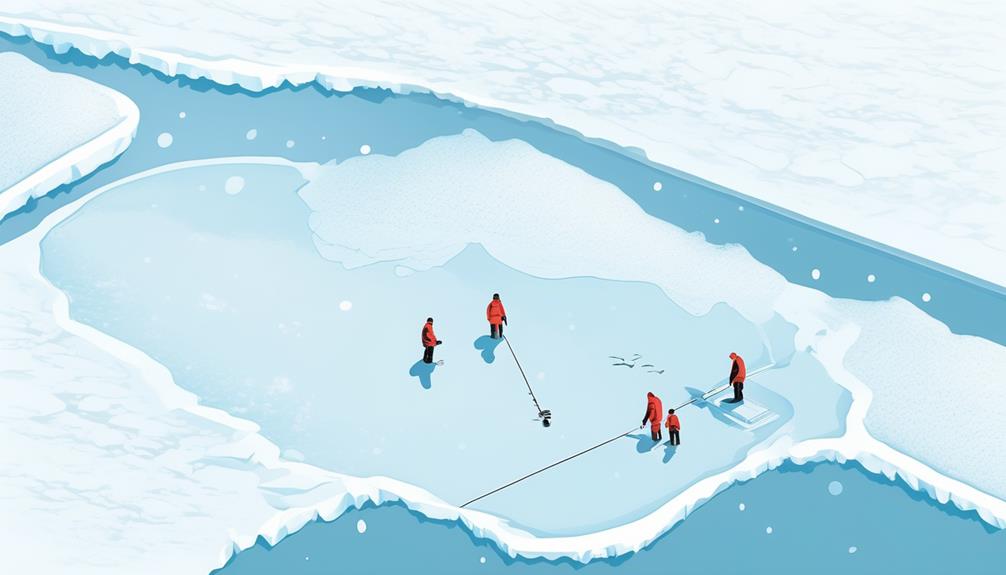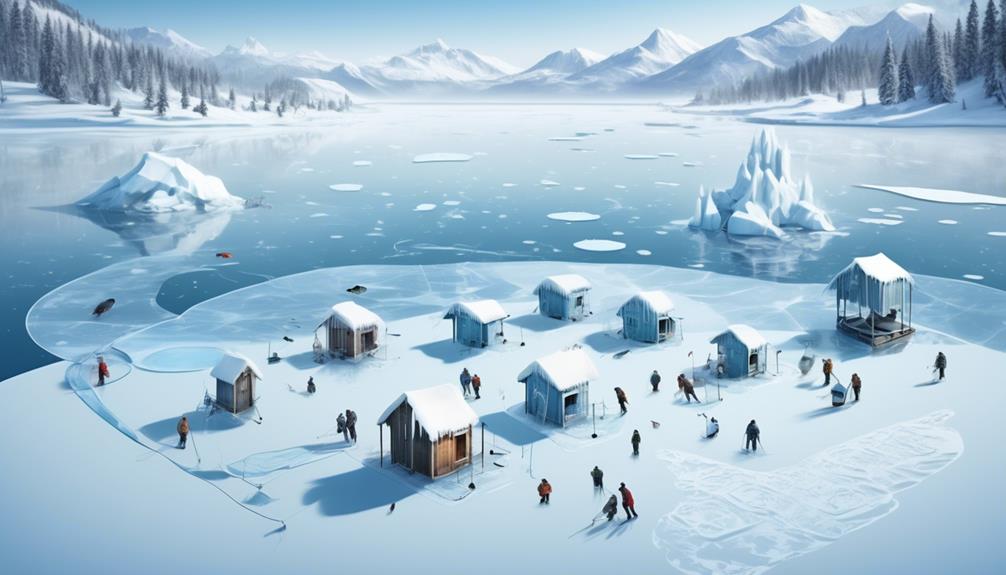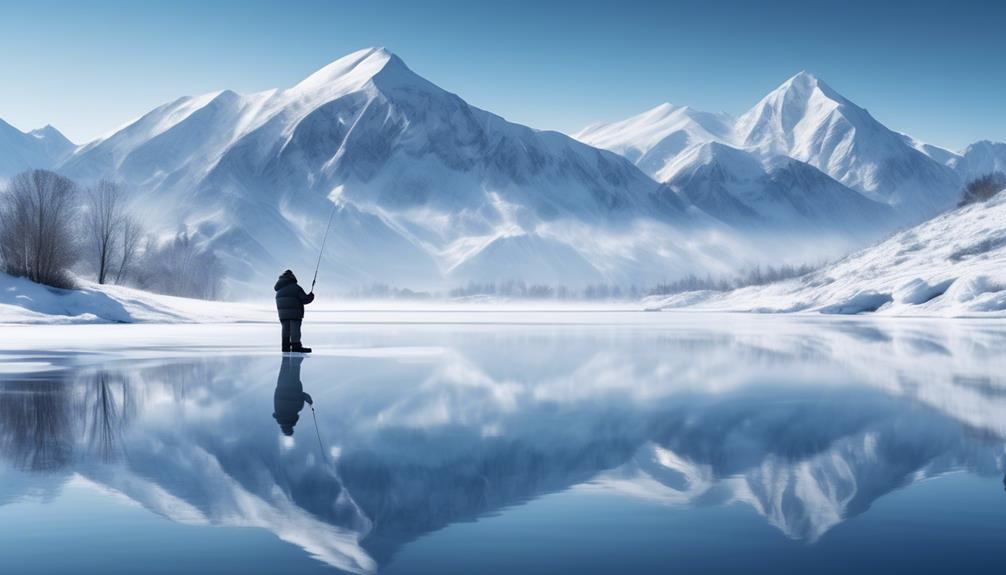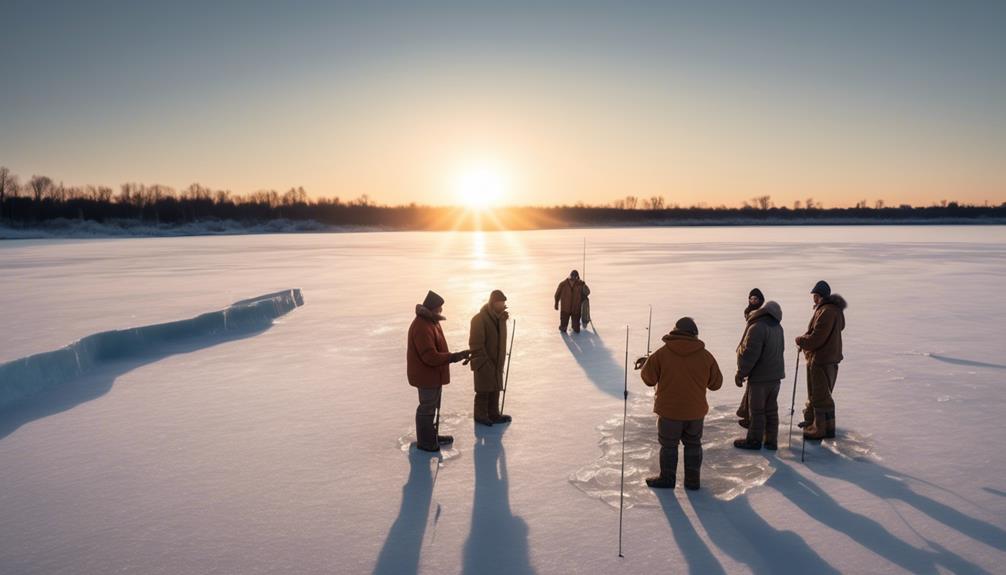You may think that all ice fishing spots are created equal, but the truth is, some are simply better than others.
Have you ever wondered why certain spots yield more fish than others, even when they seem similar at a glance?
There are several factors at play, and understanding them can significantly improve your chances of success on the ice.
Understanding Ice Formation
Understanding how ice forms can significantly improve your ice fishing experience. Ice thickness is crucial when it comes to ensuring your safety while ice fishing. As the temperature fluctuates, the thickness of the ice can change, impacting its strength and safety. It's important to be aware of the factors that influence ice formation and thickness.
Temperature fluctuations play a significant role in ice formation. When the temperature drops, water on the surface begins to freeze, gradually forming a layer of ice. However, variations in temperature can lead to inconsistencies in ice thickness. Rapid temperature changes can cause the ice to expand or contract, affecting its overall stability. Being mindful of these fluctuations is essential for determining the quality of the ice.
Monitoring ice thickness is vital for your safety. Before venturing onto the ice, it's crucial to check its thickness. One way to do this is by using an ice auger to drill a hole and measure the thickness. Generally, a minimum of 4 inches of clear, solid ice is considered safe for ice fishing. However, this benchmark can vary based on the surrounding conditions and the type of waterbody you're fishing on.
Researching Fish Behavior
To improve your ice fishing success, observe fish behavior, which is influenced by factors such as temperature fluctuations and ice thickness. Understanding fish migration patterns can significantly enhance your chances of catching fish.
During the winter, many fish species migrate to deeper waters where they can find a more stable and warmer environment. This movement is influenced by the drop in surface water temperature, so if you're aware of the typical migration patterns of the fish in the area you're fishing, you can position yourself strategically to increase your chances of a successful catch.
Moreover, researching the feeding habits of the fish you're targeting can also be crucial. Different fish species have different feeding behaviors, and understanding these patterns can help you choose the right bait and fishing technique. For example, some fish may be more active during specific times of the day, while others may be more sensitive to certain bait movements.
Locating Underwater Structures
When searching for underwater structures while ice fishing, consider using a fish finder to locate potential hotspots. Utilizing sonar mapping can help you identify underwater formations and potential fish habitats. Here's how to effectively locate underwater structures for a successful ice fishing experience:
- Sonar Mapping: Use a fish finder with sonar mapping capabilities to scan the underwater terrain. This technology will provide you with detailed images of the lake or riverbed, allowing you to pinpoint structures such as drop-offs, submerged vegetation, and rock formations where fish like to hide.
- Habitat Identification: Look for areas on the sonar map that indicate a thriving underwater habitat. Pay attention to spots with a mix of shallow and deep water, as well as areas with an abundance of underwater vegetation or natural debris. These areas often attract fish seeking shelter and food.
- Underwater Topography: Pay close attention to the underwater topography revealed by the fish finder. Look for changes in the depth of the water, as well as any irregularities in the bottom contour. Fish are often found near these underwater structures, as they provide cover and ambush points.
- Fish Behavior Analysis: Once you've located potential underwater structures, consider how they might influence fish behavior. For example, drop-offs and submerged vegetation can attract baitfish, which in turn draw larger game fish. Understanding the relationship between underwater structures and fish behavior can help you strategically place your ice fishing setup for a successful catch.
Assessing Water Depth and Currents
As you continue your ice fishing expedition, gauging the water depth and understanding the currents becomes crucial for locating the best fishing spots.
Assessing water depth is essential for ice fishing as it helps determine the potential location of fish. To do this, use a sonar or an ice fishing depth finder to measure the depth accurately.
Understanding the currents is equally important as it influences fish behavior and their movement patterns beneath the ice. Look for areas where the current may be weaker, such as near underwater structures or inlets, as fish tend to gather there.
Water temperature and visibility are also key factors to consider when assessing the water. Warmer water tends to attract fish, so areas with slightly higher temperatures may be more favorable for fishing. Additionally, clear water provides better visibility for fish, making it easier for them to spot bait. Therefore, areas with good water visibility may yield more successful catches.
When assessing the ice, always prioritize safety. Check the ice thickness regularly and ensure its stability, especially when moving to different locations. Thicker and stable ice provides a safer and more secure surface for fishing.
Analyzing Weather Patterns
Understanding weather patterns is crucial for successful ice fishing, as it can directly impact the behavior and location of fish. When analyzing weather patterns, keep in mind the following:
- Climate Change: With the changing climate, ice fishing spots that were once reliable may no longer be as productive. Warmer temperatures can lead to thinner ice, altering fish behavior and migration patterns. It's important to stay updated on climate trends to adapt your ice fishing strategies accordingly.
- Precipitation Patterns: Pay attention to precipitation patterns such as snowfall and rainfall. Heavy snow can insulate the ice, creating air gaps that affect fish movement. Additionally, excessive rainfall can cause runoff, impacting water clarity and oxygen levels under the ice.
- Wind Direction and Speed: Wind plays a significant role in ice fishing. It can influence the distribution of plankton and other food sources, consequently affecting fish movement. Understanding wind patterns can help you identify potential hotspots on the ice.
- Barometric Pressure: Changes in barometric pressure can influence fish activity. Low pressure often triggers heightened feeding behavior, while high pressure can lead to decreased fish activity. Monitoring barometric pressure can give you insight into the best times to fish.
Utilizing Technology and Tools
Adapting to changing climate conditions and understanding the impact of weather on ice fishing, you can enhance your fishing experience by utilizing technology and tools to improve your chances of a successful catch. Sonar technology and GPS mapping are essential tools for ice fishing.
Sonar technology helps you locate fish beneath the ice by sending sound waves and measuring the time they take to bounce back, providing a clear picture of the underwater environment. GPS mapping allows you to mark productive fishing spots, track your movements, and navigate safely on the ice.
Ice fishing drones have become increasingly popular for scouting and locating fish. These drones offer a bird's eye view of the ice, allowing you to identify potential fishing areas and any underwater structures that could attract fish.
Underwater cameras are another valuable tool for ice fishing. They provide real-time footage of fish behavior and the underwater environment, helping you understand fish movements and the effectiveness of your bait presentation.
Utilizing technology and tools can significantly increase your chances of a successful ice fishing trip. These advancements offer valuable insights into the underwater world, allowing you to make informed decisions and adapt your fishing techniques accordingly.
Whether it's using sonar technology to locate fish, employing GPS mapping for navigation, utilizing ice fishing drones for scouting, or gaining underwater visibility with cameras, these tools enhance your ability to identify and catch fish, ultimately improving your overall ice fishing experience.
Considering Safety and Accessibility

To ensure a safe and accessible ice fishing experience, it's essential to familiarize yourself with the ice conditions and equip yourself with the necessary safety gear. Safety precautions should always be a top priority when venturing out onto the ice. Here are some essential tips to consider:
- Check Ice Thickness: Before heading out, make sure to check the thickness of the ice. A minimum of 4 inches of clear, solid ice is generally considered safe for ice fishing. However, the recommended thickness may vary based on local conditions, so it's crucial to stay updated on ice thickness requirements.
- Wear Proper Gear: Equip yourself with a flotation suit or jacket, ice picks, and a safety rope. These items can be lifesaving in the event of an accidental fall through the ice. Additionally, wearing ice cleats can provide traction and prevent slips on icy surfaces.
- Stay Informed: Keep yourself informed about the weather conditions and any potential hazards that may affect the ice. Sudden temperature changes, strong winds, or heavy snowfall can impact ice stability, so it's important to stay updated on the local weather forecast.
- Accessible Amenities: When choosing an ice fishing spot, consider the accessibility of amenities such as restrooms, emergency services, and nearby parking. Having access to these amenities can enhance the overall safety and convenience of your ice fishing experience.
Consulting Local Experts
Considering the importance of safety and local conditions for ice fishing, consulting local experts can provide valuable insights into the best spots and the current state of the ice. Local knowledge and community engagement are crucial when seeking expert advice and insider tips for a successful ice fishing experience.
Engaging with local experts allows you to tap into their wealth of knowledge about the area's top ice fishing spots, the thickness and quality of the ice, as well as the behavior of the fish in different weather conditions. Local experts are often avid ice fishermen themselves and have spent years honing their skills on the frozen lakes and rivers in the area.
Their expertise can be invaluable in identifying the most productive fishing locations, understanding the unique characteristics of the local fish species, and learning about the safest routes on the ice. By actively engaging with the local fishing community, you can gain access to insider tips that may not be readily available through other sources.
In addition to providing practical advice, local experts can also offer insights into the cultural and social aspects of ice fishing in the area. Understanding the local traditions, preferred bait and tackle, and customary practices can further enhance your ice fishing experience and foster a deeper connection with the community.
Therefore, consulting local experts not only improves your chances of a successful fishing trip but also enriches your overall experience on the ice.
Frequently Asked Questions
How Do Different Types of Bait and Lures Affect Ice Fishing Success?
When ice fishing, bait selection and lure presentation can greatly affect your success. Different types of bait and lures work better in varying temperatures and water clarities. Understanding these factors will help you reel in more fish.
What Are Some Common Mistakes That Ice Fishermen Make When Choosing a Spot?
When choosing an ice fishing spot, common mistakes include neglecting to check ice conditions, rushing equipment selection, not scouting the location, and overlooking fish behavior. Avoid these errors by being thorough and observant.
Are There Any Specific Times of Day That Are Better for Ice Fishing?
For the best times to increase your ice fishing success, consider specific times of day. Early mornings and late afternoons tend to be successful ice fishing spots, as fish are more active during these times.
How Does the Presence of Other Anglers Affect the Success of an Ice Fishing Spot?
When ice fishing, the presence of other anglers can impact your success. Social dynamics and competition may affect the fish's behavior. Noise and activity from other anglers could also spook the fish, making them less likely to bite.
What Are Some Tips for Staying Warm and Comfortable During Long Days of Ice Fishing?
When ice fishing, staying warm is key. Layer up with thermal clothing and insulated boots. Hand warmers and portable heaters can also help. Remember to stay dry and keep moving to maintain warmth.
Conclusion
So, next time you're planning your ice fishing trip, remember to consider all these factors to find the best spot.
Understanding ice formation, researching fish behavior, locating underwater structures, assessing water depth and currents, analyzing weather patterns, utilizing technology and tools, considering safety and accessibility, and consulting local experts will all contribute to a successful and enjoyable ice fishing experience.
Happy fishing!



